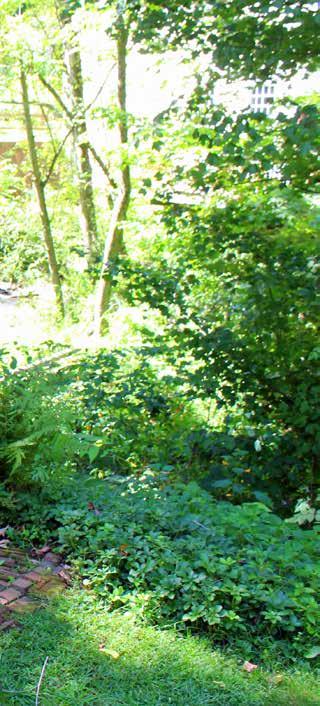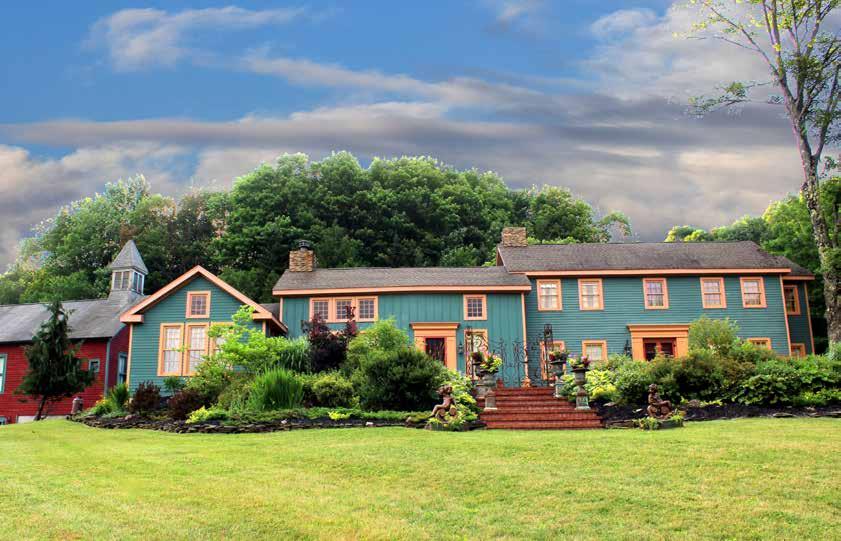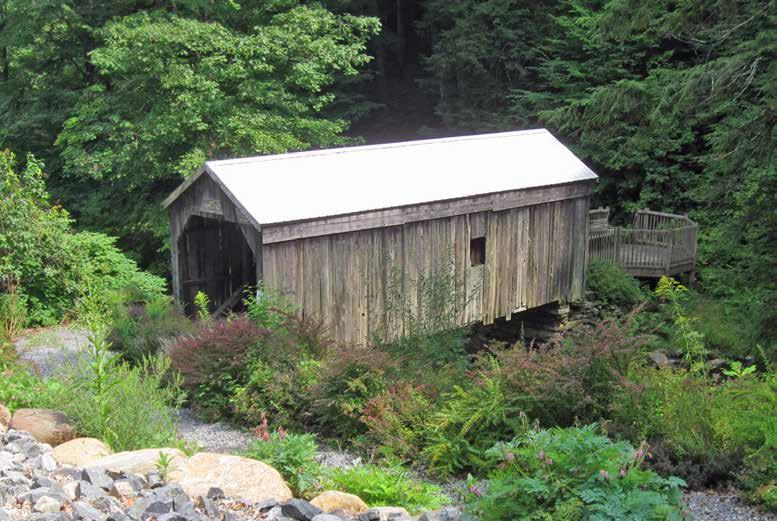
13 minute read
Need to Get Away?
RECYCLE THE
HOUSE WRITTEN AND PHOTOGRAPHED BY THERESA ST. JOHN
Transforming an 1845 Nondescript Structure to Quirky Renovation
When Kim Senay, a longtime resident of Chester, Connecticut, first purchased an overgrown property across the street from his residence on Spring Street, I’m not sure he had an inkling of what he was in for, breathing new life into the old homestead again. I’d never heard of Chester – but it’s a charming little town, just a few hours away from Saratoga. The weekend my friend and I travel there, excited about our overnight stay at an advertised glamping property, the main street is closed to foot traffic only.
We park the car and wander through various art shops, stopping for a bite to eat at a pub-like restaurant, sitting outside under umbrellas listening to local musicians, and trying some Chakra tonics from a nearby health store. Everyone is friendly this sunny afternoon, and we’re content walking through the center of Connecticut’s little hamlet. We buy some fresh food from the farmers market – ripe, juicy tomatoes, a loaf of bread, and a two-year-old block of cheese. They’ll be perfect items to enjoy later, alongside two or three bottles of wine we’d packed for our adventure. Soon, the vendors pack it in for the day. Once the street clears, we jump into the car, making our way to the place we’re staying for the night. The Recycle House sits on a hill, less than a minute from where we’ve spent the last few hours. A hand-carved sign on the side of the building announces our arrival. The color of the house is a deep, forest green – which helps it blend in with the lawn’s healthy green grass, tree branches covered with thick foliage, and flowering bushes surrounding the property. An old, weathered brick and stone walkway leads us down the hill, where a charming little gardening shed and two Adirondack chairs face this fantastic waterfall known as Pattaconk Brook. My friend and I sit for a while, not anxious to unpack yet. The sounds of nature – the absence of our busy lives back home is so calming we’re fine just sitting still for a few moments. I can tell there’s something different about this two-story home. Mostly, the fact that it isn’t picture-perfect calls to me. The mismatched lettering on the sign out front seems like a badge of courage – as if the home is proud to be constructed from recycled items. And, truthfully, it should be. Kim acquired most of the materials used in the house from dumpsters or contributions from people gifting items they were going to get rid of anyway. “Even if I thought there was no way I’d be able to use what folks offered, I accepted everything. In the beginning stages, I just didn’t know what would come in handy or fit a space perfectly.” He also decided he wouldn’t cash in on things that were donated. If Kim couldn’t use something in this monumental project, he’d find it a home someplace else. And although he did a great deal of the work himself, Mr. Senay had helpers along the way. We walk through each room of the house, impressed with its unique craftsmanship. There’s evidence of salvaged wood from an old barn he’d helped demolish, kitchen backsplash tiles that match the coffee cups and plates for dining.








Wood planks from an old schoolhouse cover the living room walls; some still have the initials of children carved in them. More wood from that same structure became floorboards in other rooms of the home.
We’re surprised to find that an eye-catching bookcase in the bedroom opens up to a spacious deck. We later learn it was an old show prop Kim bought at a Goodspeed Opera House tag sale.
Odd-shaped windows hang in nooks and crannies throughout the second floor, allowing natural light inside. Even the handmade basket by Chester’s artist Sosse Baker – discovered at the dump in perfect condition, sits on the dining room table, a warm welcome to overnight visitors. Double-paned windows, used as an outside wall in the living area, allow the downstairs to bask in sunshine throughout the day. Old glass-paned doors now serve as cupboards – storing games, blankets, and towels on shelves just outside the kitchen.
Comfy red chairs arranged around a pot-belly stove are an open invitation for us to relax and unwind after our day of shopping. Everything about the house and yard is quirky. But it’s all come together in a message that sings of home and hearth. We only stayed one night. We slept like babies, woke refreshed, determined to make it back again – for a more extended stay next time.
For more information on The Recycle House or another property, contact GlampingHub.com S S


When You Need a Fairytale Getaway With Old-World Charm Blueberry Brooke B & B~

WRITTEN AND PHOTOGRAPHED BY THERESA ST. JOHN
Have you ever walked into a place and felt an instant affinity, almost as if you’d been there before and everything is familiar? That’s how we felt during our overnight stay at Blueberry Brooke Bed & Breakfast, in Deansboro, New York. (about two hours west of Saratoga) The 1860’s farmhouse, located on an organic blueberry farm, inspired Virginia Palusky to give voice to her dream of Blueberry Brooke and the world-class bed & breakfast she wanted it to be. She teamed up with her father, Brooke, spending hours on the design. With his guidance, the structure was re-imagined from the ground up, offering guests a storybook charm I’ve never seen before and probably won’t again. We park the car and empty it, carrying our suitcases and camera bags towards the kitchen door, where a detailed email had instructed us to enter. Before we even got there, a slightly-built woman in a humongous, ornately decorated hat comes walking towards us. “Welcome to Blueberry Brooke,” she sings out. Her voice is melodious, like a songbird’s warble in the dusk that surrounds the three of us. She introduces herself, embracing us in a warm, inviting hug and thanks us for visiting. “There are so many wonderful places you could have chosen,” she tells us. “We’re happy to have you.” Virginia leads the way into her home. The first room we enter is the kitchen, where our mouths fall open in surprise. I’ve often heard people talk about how the kitchen is the ‘heart of the home.’ For me, this is true. A kitchen evokes childhood memories, a place where my family gathered for meals, to get homework done every afternoon, to sit and chat over a cup of coffee or tea.



At Blueberry Brooke, within the large, airy room, it is the same. Every inch of the space is appealing – from the countertops covered in freshly baked goods and bowls of just-picked blueberries to the hand-crafted wood shelves displaying all sorts of cookbooks to the dining table decorated with vases, more food, and family heirlooms, it all felt like ‘home.’ I’m traveling with a girlfriend for the weekend. I watch as she steps toward the bookcase, fingering the cookbook bindings cracked with age. “Oh my gosh!” she squeals, turning towards us with an old edition in her hands. “My grandmother had this cookbook. I remember it being out on the counter near the stove. She’d pour over the pages, figuring out what to make for dinner.” Her eyes become misty as she returns the volume to the shelf where it belongs. Virginia is an artist. In the living room, her colorful pottery has become part of the fireplace mantle. “ My mom was a potter,” I tell her, my voice cracking over the memory of her loss. “She had a potter’s wheel and kiln in the cellar of our house. We took a few classes together. Mom and I loved the feel of throwing clay, watching it come to life as we worked with it.” My eyes move around the area and find other sparks and explosions of her creativity – things that Virginia explains the meaning behind, later that evening. “Let me show you to your rooms,” she says. “I think you’ll like them.” She leads me into an enchanting room Inspired by Shakespeare’s comedy of love, ‘Midsummer Night’s Dream.’ Featuring a queen and double bed, beautifully restored settee sofa, large private bathroom with jacuzzi tub and many other personal touches, the room feels like I’ve stumbled into the pages of his play and the marriage of Theseus, the Duke of Athens and Hippolyta, the Amazonian queen who possessed a magical girdle. Other rooms included ‘Under the Tuscan sun,’ ‘Once in a Blue Moon,’ ‘The Artist’s Dream,’ and ‘Fleur de Provence.’ We set our bags down and drink a glass of wine outside under the starry night. When we fall into beds an hour later, our rooms next to each other, sleep comes easy. I wake to the smells of coffee and breakfast cooking. Wandering into the brightly lit kitchen I look towards the dining table and marvel at the spread Virginia’s been busy for hours preparing. Everything we could want – from lemon pound cake and crepes to egg-white omelets and fresh fruit, to pancakes, bacon, and sausage, bowls of fresh blueberries, and pats of butter decorated with pansies was there. Unreal. We meet Bob, her husband, and a glass and ceramic sculpture artist known all over the world. Sitting with both of them over our morning feast, we learn a little bit about their artistic style and how each piece portrays a moment in their life together.

We visit the workshop after helping clean up our dishes and talk about the inspiration for the bright and colorful pieces on display there. Virginia and Bob love working with their hands and documenting their unique love story with glass-blowing and ceramic creations. Their emotion shows.

We pick blueberries to bring home. We wander the grounds again, the rooms of the bed & breakfast that are chock-full of history, culture, and living. It’s hard to pack our bags and get ready to leave. We get and give a warm bear-hug. Virginia and Bob walk us to the car. “Can you wait here just a minute?” Virginia asks. She turns to run inside the house. A minute or so later she runs out holding three hats, handing one to each of us. “Let’s take a selfie out here in the garden.”
And that’s my favorite memory – making new friends in the best places, like the pages of a fairytale.
S S As far as Bob and Virginia’s fairytale love story? You’ll have to go to Blueberry Brooke yourself and see if they’ll tell you. I can’t do it justice. S S



THE COPELAND COVERED BRIDGE A Beacon of Bygone Days:

WRITTEN AND PHOTOGRAPHED BY WENDY HOBDAY HAUGH
Copeland Covered Bridge and viewing station.
If you’re looking for a lovely spring ride, a picturesque picnic spot, and a bit of history to boot, why not visit the Copeland Covered Bridge? Located in Edinburg in the quaint community of Beecher Hollow, this one-lane, 35-foot long bridge has the distinction of being the last remaining covered bridge in Saratoga County. Situated at 46 North Shore Road (aka County Route 4, the road paralleling the northern rim of Great Sacandaga Lake), the Copeland Historic Site may seem small at first, little more than a roadside pull-off. But there’s something magical about the place, and no matter how long or short your stay, it makes an indelible impression. The rustic bridge and peaceful setting transport you back in time, offering a nostalgic glimpse of rural life in the 1800s, decades before a grand feat of engineering turned the peaceful Sacandaga River Valley into Great Sacandaga Lake. The Copeland Covered Bridge was built in 1879 by Arad Copeland, a wheelwright and woodworker who also farmed 35 acres of land across Beecher Creek from his home. For many years, an open bridge enabled the farmer to herd his cows to pasture. But after a fierce springtime snow and ice jam destroyed the footbridge, Arad decided to build a sturdier covered structure. Neighbors pitched in, skillfully laying dry-fitted stone support walls on either side of the creek, hewing timbers, and assembling the wooden frame. Take a look at the underside of the bridge today, and you can still see the carefully laid stones and bark-covered floor joists. Look up as you cross the bridge, and you’ll notice rustic wooden pegs protruding through the woodwork, effectively anchoring the massive beams. Queen post trusses were used to support the bridge’s roof. Adding to its distinction, the Copeland Covered Bridge is said to be the only covered bridge in New York State with this type of truss design. For illumination and beauty, Arad graced his bridge with two strategically placed windows. The upstream window offers a stunning view of Beecher Falls, the series of waterfalls which powered the sawmill and carriage shop owned jointly by Arad and his brother, Leonard. The bridge’s second, downstream window frames a picture-perfect view of the fine red brick home that Arad built for his bride, Anna, circa 1832. The Copelands’ stately homestead still stands today. Copeland Covered Bridge historical marker.


Used only for foot traffic, The Copeland Covered Bridge held up well and remained an integral part of the family for 118 years. In 1997, however, Arad’s great-great-grandson, Robert Tyrrell, and his wife, Betty, generously deeded their ancestral bridge to the Edinburg Historical Society, thereby ensuring its vigilant care for generations to come. Through the combined efforts of the Edinburg Historical Society and the Town of Edinburg, the Copeland Covered Bridge underwent numerous repairs and upgrades in the early 2000s. Rotted floorboards and sideboards were replaced, and an all new metal roof was installed. A lovely viewing platform was built at the far end of the bridge, overlooking a scenic picnic area, Beecher Creek, and the waterfalls. A wooden boardwalk was also erected upstream from the bridge. Running alongside the creek, it welcomes visitors to a second bench-lined viewing station directly beside the falls. Photo ops abound, so be sure to bring a camera. The Copeland Covered Bridge was placed on the State and National Registers of Historic Sites in 1998. An informative marker greets you as you pull off North Shore Road and park. At the start of the wooden boardwalk, an illustrated exhibit provides further details about community life in Beecher Hollow during the 18th and 19th centuries. Without a doubt, the Copeland Covered Bridge is an enchanting destination in any season. But seeing it in springtime, when the falls are thundering with winter snowmelt and the creek is flowing full throttle, is nothing short of spectacular. So, pack a picnic lunch . . . and don’t forget your camera!
Visit the Copeland Covered Bridge at 46 North Shore Road (County Route 4), Edinburg, NY;
limited roadside parking available. S S













